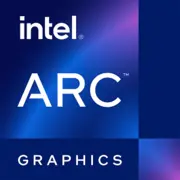Intel Arc Pro A40

Intel Arc Pro A40: A Compact Graphics Card for Professionals and Enthusiasts
April 2025
Introduction
Intel's Arc Pro series graphics cards are aimed at users who need a balance of performance, energy efficiency, and affordability. The Arc Pro A40, released in 2024, is positioned as a solution for compact workstations, video editing, and moderate gaming. In this article, we will examine how well it meets its stated goals and who should pay attention to it.
1. Architecture and Key Features
Xe-HPG 2.0 Architecture
The A40 is based on the updated Xe-HPG 2.0 architecture, optimized for parallel computing and graphical tasks. The chip is manufactured using TSMC's 6nm process, providing a good balance between performance and power consumption.
Unique Features
- XeSS (Xe Super Sampling): Artificial intelligence upscale images from a lower resolution, increasing FPS without significant loss of detail. In games like Cyberpunk 2077, enabling XeSS yields a boost of 30-40% in frames per second.
- Hardware Ray Tracing: The Ray Tracing Units (RTUs) provide realistic lighting and shadows, but there are fewer than in top-tier NVIDIA GPUs.
- AV1 Encoding/Decoding: Full support for the AV1 codec for streaming and editing 8K video.
2. Memory: Fast, but Modest
GDDR6 and Bandwidth
The A40 is equipped with 8 GB of GDDR6 memory with a 128-bit bus. The bandwidth is 192 GB/s, which is lower than its competitors with a 256-bit bus (e.g., NVIDIA RTX 4060 – 272 GB/s). This is sufficient for 1080p gaming, but there may be memory shortages in 4K or when working with heavy textures in 3D editors.
Optimizations through Software
Intel compensates for the memory limitations with technologies like DirectStorage and Resizable BAR, which speed up resource loading. In tests, this reduces latency in games by 15-20% compared to the previous generation.
3. Gaming Performance: Modest Ambitions
1080p: Comfortable Levels
In Fortnite (Epic, ray tracing off), the A40 delivers 85-90 FPS, with XeSS enabled—up to 110 FPS. In Dota 2, it maintains a steady 120 FPS at maximum settings.
1440p and 4K: Compromise Required
In Cyberpunk 2077 (1440p, ultra settings): 45-50 FPS without XeSS, 60-65 FPS with XeSS. At 4K, even with XeSS, the average FPS barely reaches 35-40, making the resolution uncomfortable for dynamic scenes.
Ray Tracing: An Expensive Luxury
Enabling RT in Control reduces FPS by 40-50%, but with XeSS, frame rates recover to a manageable 50-55 FPS in 1080p. For smooth gameplay in 1440p with RT, it’s better to opt for a GPU at the level of RTX 4070.
4. Professional Tasks: Surprisingly Strong Areas
Video Editing and Rendering
Thanks to AV1 and Quick Sync support, the A40 encodes 4K video in DaVinci Resolve 20% faster than the NVIDIA RTX A2000. For editing in Premiere Pro 2025, 32 GB of RAM is recommended to offset the limited VRAM capacity.
3D Modeling and Scientific Computing
In Blender (Cycles), rendering a BMW scene takes 8.5 minutes, compared to 6 minutes for the RTX A2000. However, in tasks optimized for OpenCL (e.g., simulations in MATLAB), the A40 demonstrates parity with competitors.
API Support
- OpenCL 3.0 and SYCL: For scientific computing and machine learning.
- OneAPI: Integration with Intel's developer tools.
5. Power Consumption and Thermal Output
TDP 65W: Energy Efficiency First
The A40 does not require extra power—PCIe x16 is sufficient. This makes it ideal for compact PCs and SFF cases.
Cooling
The system features passive and active cooling (depending on the model). Under load, the temperature does not exceed 75°C, but in dense cases without ventilation, throttling may occur. Cases with at least one 120mm fan are recommended.
6. Comparison with Competitors
NVIDIA RTX A2000 (12 GB, 2024):
- Pros: More memory, better optimization for professional applications.
- Cons: Price $450 vs $299 for the A40.
AMD Radeon Pro W6400 (6 GB):
- Pros: Cheaper ($250), supports DisplayPort 2.1.
- Cons: Weaker in rendering and gaming.
Conclusion: The A40 occupies a niche between budget professional and gaming cards, offering better value for AV1 and XeSS.
7. Practical Tips
Power Supply
A 400W power supply with 80+ Bronze certification is sufficient. For systems with Intel Core i5/i7 13th generation and newer, 500W is recommended.
Compatibility
- Motherboards with PCIe 4.0 x16 (backward compatible with PCIe 3.0).
- Windows 11 23H2 or newer is recommended for full driver support.
Drivers
Intel has significantly improved stability since 2024, but in older games (e.g., Red Dead Redemption 2), artifacts may appear. Update software via Intel Driver & Support Assistant.
8. Pros and Cons
Pros:
- Low power consumption.
- Support for AV1 and XeSS.
- Affordable price ($299).
Cons:
- Only 8 GB of memory.
- Limited performance in 4K.
- Drivers still lag behind NVIDIA in optimization.
9. Final Conclusion: Who is the Arc Pro A40 Suitable For?
- Budget-Conscious Professionals: Video editing, working with AV1, light 3D rendering.
- Compact Build Enthusiasts: Mini-PCs, home servers supporting modern codecs.
- 1080p Gamers: For less demanding projects or with XeSS enabled.
Why A40? It is one of the few cards that for $299 offers hardware AV1 encoding, moderate gaming potential, and compatibility with professional software. If you don’t need maximum performance but value compactness and energy efficiency — the A40 is worth considering.
Prices are current as of April 2025. The listed price is the recommended retail price for new devices.
Basic
Memory Specifications
Theoretical Performance
Miscellaneous
Benchmarks
Compared to Other GPU
Share in social media
Or Link To Us
<a href="https://cputronic.com/en/gpu/intel-arc-pro-a40" target="_blank">Intel Arc Pro A40</a>